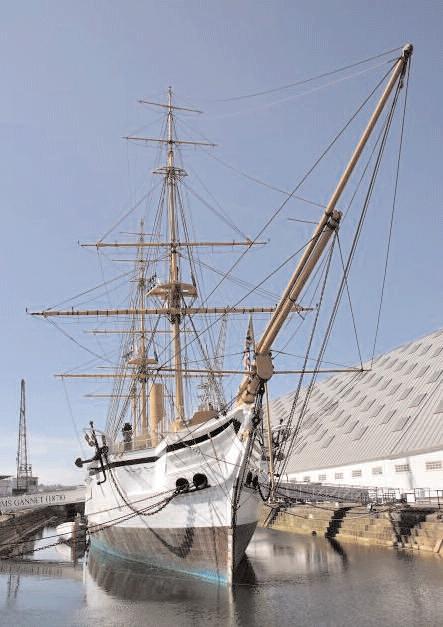Plunge into Chatham's naval history

“Best reinvention of a de-commissioned dockyard" – I’m not sure if there is such a prize, but if there is, then I have no doubt of the winner. One good reason that Britain ruled the waves (mostly) from Elizabethan times to the Second World War was Chatham Dockyard, a place of tremendous energy and innovation. HMS Victory was just one of the ships that was launched here.
This vast site closed in 1984: a traumatic time for the Medway towns, yet from which one of the leading attractions in South-east England has emerged.
You appreciate the weight of history as soon as you arrive, because the old gates are still standing. You can plumb the depths of life aboard a Royal Navy submarine, and – some weekends – watch steam trains fizz, splutter and rumble along the dockyard’s ancient tracks.
Perhaps the Dockyard’s greatest strength is the way the essential fabric of the naval base has been so assiduously preserved. The exhibits are curated into the marvellous muddle of historic buildings that range through Tudor, Stuart and Georgian eras, and which supported the Royal Navy right through from the Spanish Armada to the Falklands War. A favourite of mine is No 3 Slip, whose prosaic name only hints at the magnificent space beneath a canopy so broad that, when it opened in 1838, was Europe’s widest timber structure.
Starting this year, a brand-new attraction claims to be an “all-round treasure house”. No 1 Smithery brings together many great naval treasures that, until now, have been split between Chatham Historic Dockyard, the National Maritime Museum in Greenwich and the Imperial War Museum in Lambeth, south London. In a sense, this added dimension to |the dockyard is a cultural rationalisation – but with plenty of inspiration in the way that previously unseen maritime artefacts are displayed alongside great naval art and intricate model ships.
There is also a programme of touring exhibitions, starting with Stanley Spencer’s vivid pictures of “Shipbuilding on the Clyde” (until 12 December). These paintings – breathtaking in scale and detail – depict the decades when the banks of the river west of Glasgow comprised the centre of the maritime world. They are on display alongside tools from the Chatham Smithery of the kind that the Clydeside workers would have used.
Chatham Historic Dockyard (01634 823807; thedockyard.co.uk ). Open 10am-6pm until 30 October; 10am-4pm from 31 October until 12 December 2010. Admission £15.
A GLIMPSE INTO THE PAST: HAMPSHIRE'S MUSEUMS
Dotted throughout Hampshire are a host of museums providing a fascinating insight into the county’s past.
At Basingstoke Leisure Park, about a mile west of the town centre, a team of designers has recreated a network of streets that bring to life the Victorian and Edwardian eras. Milestones Museum is a wonderful place of nostalgia and old-fashioned charm celebrating the life and times of the area from the late 1800s to the 1930s. You can pop into a post office, stop at an Edwardian pub, and relax on a village green. There’s even a railway station complete with a 1910 Woolmer steam locomotive. You’ll also find a large collection of vehicles – bicycles, carriages and vintage cars – parked on the streets. The museum is peopled by costumed interpreters. (Milestones Museum, Leisure Park, Churchill Way West, Basingstoke; adults £7.90).
Old Basing, three miles east of Basingstoke, contains the site of Basing House, an atmospheric ruin with beautiful grounds, it was once one of the finest palaces in the land. Today, the site contains the remains of the residence of Elizabeth I’s Treasurer, William Paulet. It became a Royalist stronghold during the Civil War before being destroyed by Cromwell’s troops. The museum presents the history of the house, while the grounds continue to be excavated and are often open to volunteer groups. There is also a lively programme of events, from Civil War re-enactments to a ghost walk on Saturday 30 October. (Basing House, The Street, Old Basing, Basingstoke; adults £4.50).
More wonders can be found at Rockbourne near Fordingbridge. Rockbourne Roman Villa was discovered in 1942 by a farmer looking for his ferret. Excavations revealed more than 40 rooms. Highlights include bath houses and mosaics. (Rockbourne Roman Villa, Rockbourne, Fordingbridge; adults £2.50).
For a gem of a restored building, head to Bursledon village, east of Southampton city centre. The Bursledon Windmill is a working structure, built in 1813. You can explore the mill and farm buildings. (Bursledon Windmill, Bursledon, Southampton; adults £3).
Other treasures of Hampshire include the Museum of the Iron Age in Andover, the Allen Gallery with its impressive collection of ceramics in Alton, and The Red House at Christchurch, Dorset, which is funded by Hampshire although the county boundaries have changed. The Georgian workhouse now contains a museum of the area’s social and natural history.
For more information, visit hants.gov.uk/museums (0845 603 5635)
Subscribe to Independent Premium to bookmark this article
Want to bookmark your favourite articles and stories to read or reference later? Start your Independent Premium subscription today.

Join our commenting forum
Join thought-provoking conversations, follow other Independent readers and see their replies